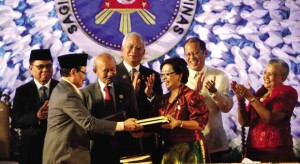COTABATO CITY, Philippines — An heir to the old sultanate of Kabuntalan has complained about the apparent exclusion of their historic inland sultanate from the cultural heritage provision of the Bangsamoro Basic Law (BBL).
Sultan Dikaya Tungko Saikol said in his Facebook account that he and his kin were saddened upon seeing that the sultanate (now part of the modern day Maguindanao province) was not mentioned in the BBL’s Article IX.
Section 19 of Article IX provides the “Preservation of Bangsamoro Cultural Heritage.”
“To preserve the history, culture, arts, tradition and the rich cultural heritage of the sultanates, such as the sultanates of Sulu, Maguindanao and Buayan, and the Royal Houses of the Maranaos and the Indigenous Peoples of the Bangsamoro, there shall be created a Bangsamoro Commission for the preservation of cultural heritage,” the section of the proposed law said.
Saikol said the old dominion of the Kabuntalan sultanate, although now part of Maguindanao province, was distinct from the sultanate of Maguindanao. It was the same case as the sultanate of Buayan, now also part of Maguindanao.
Moro history said the sultanate of Kabuntalan was situated between the territories held by Buayan (upstream) and Maguindanao (downstream) with reference made largely on the Mindanao River.
Dr. Amor Pendaliday, an official of the Autonomous Region in Muslim Mindanao, said the exclusion put Kabuntalan, a historic royal dominion, in the ranks of “little-known” sultanates.
Saikol said the sultanate of Kabuntalan had been left out in past historical documents, and this could be the “nth time” it happened.
He urged Maguindanao Representative Bai Sandra Sema, also a descendant of the old sultanate of Kabuntalan, to help correct the same error that has it in historic isolation since the 1596 “Battle of Tampakan” between natives, under Rajah Silongan, and the Spanish expedition of Capitan Esteban Rodriguez de Figueroa.
Tampakan is a very small part of Kabuntalan, according to Saikol.
But because early historians failed to name it as a place of important events, the people of Kabuntalan were almost identically known as the natives of Tampakan, Saikol said.
Historian Cesar Adib Majul mentioned Tamontaka, a village which used to be part of Kabuntalan, in reference to Sultan Jafar Sadiq Manamir, who assumed and set up his court in Kabuntalan, when he contested the rule of his brother Sultan Bayanul Anwar of Maguindanao in 1733.
Saikol, environment and natural resources director for Region 12, said traditionally, the Maguindanao and Buayan sultanates were “siblings,” and the Kabuntalan royal house was their “offspring.” Genealogically, Manamir’s mother was from Buayan and his father, Barahaman, was the ninth sultan of Maguindanao.
But Saikol also noted that Vic Hurley, author of the book entitled “Swiss of the Kris” mentioned Kabuntalan several times as a sultanate distinct from Maguindanao and Buayan.
Many educated Maguindanaon Muslims have been descendants of the Kabuntalan sultanate — among them, historian Alunan Glang, Carpenter Lauban, former Justice Secretary Simeon Datumanong, former Congressman Didagen Dilangalen, Cotabato City Mayor Guiapal Guiani Jr., lawyer Suharto Ambolodto, a consultant for the Australian Embassy; career ambassador Said Glang, journalist Hader Glang, and Bangsamoro Transition Commission Chairman Mohaguer Iqbal.
RELATED STORIES
Key Bangsamoro details to find way into basic law
IPs protected in Bangsamoro, says lawmaker
